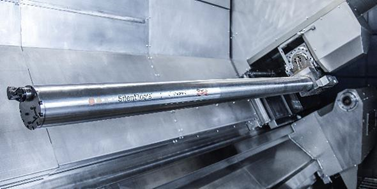
Sandvik Coromant, Mebane, North Carolina, has launched The Silent Tools™ Plus boring bar, a vibration-damped sensor boring bar with control integration. Its sensors provide data on utilization, temperature, deflection and surface quality achieved, and also intervene adaptively in the machining process if the limit parameters are exceeded. The process transparency gained allows the machining process to be significantly optimized.
Improved Performance with Smart Tools
Integrating smart sensors enables detailed tool information and machining states to be called up on the machine control system, a tablet or a PC. Various sensors installed in the Silent Tools™ Plus boring bar provide data on load, temperature, deflection and more. Signals are transmitted via Bluetooth so that the machine can interactively respond to a defined trigger event. The process can be visualized and documented, making it fully transparent. Using an inductive coupling to power the sensors instead of an accumulator is a new feature.
The Ultimate Protection for Machines, Workpieces and Tools
The Silent Tools™ Plus boring bar has integrated sensors in different places. A vibration sensor fitted to the cutting head detects vibrations even at an early stage. The operator or machine control system can react in real-time, preventing the problems commonly associated with vibrations and thus reducing scrap rates and rework. A temperature sensor built into the damping unit monitors the actual temperature, which is also displayed. This increases process reliability and ensures better maintainability of the boring bar. Sensors are also installed in the boring bar itself, which provides data on the force being exerted on the bar.
In combination with the “iControl” process monitoring system, the operator enjoys the ultimate level of protection for the machine, workpiece and tool to ensure reliable and economical production, especially in spare parts production or for small batch sizes. On the one hand, the machine and tools should be used with maximum productivity; on the other hand, the process should run as stably and reliably as possible. The up to 16 process signals to be monitored are configured by WFL at the factory according to the machine equipment and displayed live on the controller’s screen. Important process signals are the forces or torques of the NC axes and spindles, but also the signals derived from the sensors integrated with the Silent Tools™ Plus boring bar.
The learning mode of WFL iControl offers an excellent strategy. The process signal of an entire machining sequence with the Silent Tools™ Plus boring bar can be recorded through a learning cut. The allocation of upper and lower process limits defines the tolerance band within which the process signal must remain during machining. If these limits are violated, the machine will stop. When using a new cutting insert, for example, a certain process limit can be set at the beginning of the machining process with the help of the load signal. Within just a few millimeters, the user receives information about the cutting force and can set a limit including an appropriate allowance. The machine automatically will detect an overload situation at any point in the machining process.
Holistic Solutions
The ability to implement holistic solutions is important for complete machining. In the larger MILLTURNs there is an additional compound slide to accommodate a large vibration-damped boring bar with a length-diameter ratio of up to 18xD. The additional compound slide enables an automatic tool change at the front of the boring bar, a programmable projection length and Ultra High Pressure Coolant (UHPC).
Advantages:
- Sensors in tools provide additional protection for the workpiece, tool and machine
- Reduced workload for operators
- Greater process reliability during machining
- Early detection of overloads and vibrations during the machining process
- Integration in WFL iControl Advanced+
- Documentation of the force curve during the process
For more information, visit www.sandvik.coromant.com.


